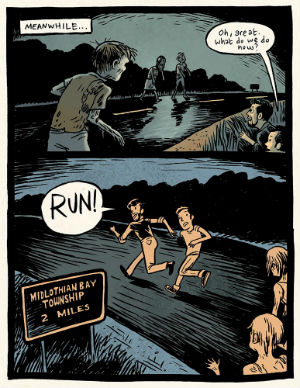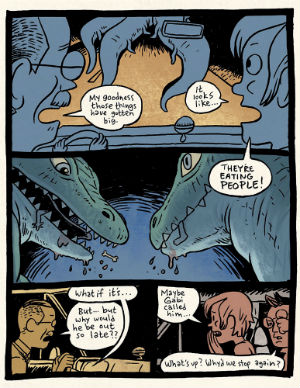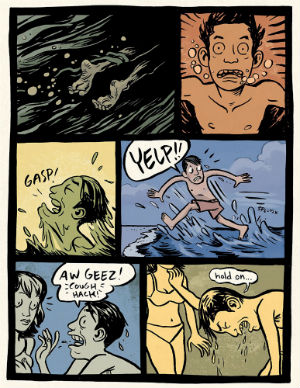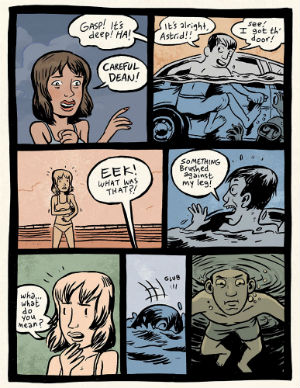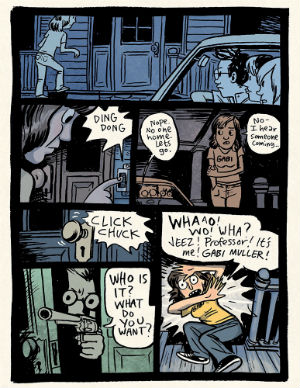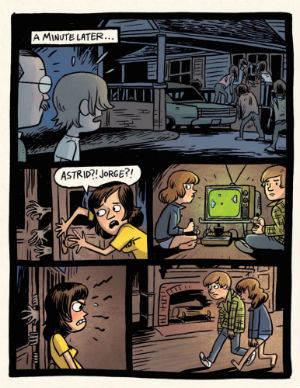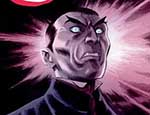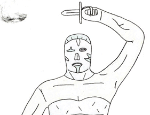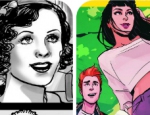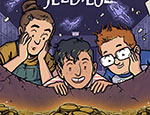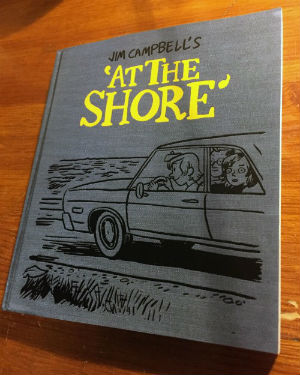 Jim Campbell’s At the Shore is a graphic novel that highlights the changing tides in indie comics from the early part of the 2000s to the present. Much of that has to do with the eleven years between 2005 and 2016 that Campbell worked on the project. What begins as a smaller, more personal, story of a group of college kids taking a trip to the beach and running afoul of sea-borne zombies becomes by its end a rollicking horror comedy adventure. It would seem that Campbell’s time away from At the Shore working as a colorist for Marvel and DC, as well as his work on Over the Garden Wall, shifted and reshaped the series. Not that any of this is a bad thing, as Campbell handles several modes of storytelling well throughout, and ends up creating a more interesting work for it.
Jim Campbell’s At the Shore is a graphic novel that highlights the changing tides in indie comics from the early part of the 2000s to the present. Much of that has to do with the eleven years between 2005 and 2016 that Campbell worked on the project. What begins as a smaller, more personal, story of a group of college kids taking a trip to the beach and running afoul of sea-borne zombies becomes by its end a rollicking horror comedy adventure. It would seem that Campbell’s time away from At the Shore working as a colorist for Marvel and DC, as well as his work on Over the Garden Wall, shifted and reshaped the series. Not that any of this is a bad thing, as Campbell handles several modes of storytelling well throughout, and ends up creating a more interesting work for it.
At the Shore begins with the exploits of art school goofs Gabi, Bernard, Dean, Astrid and Jorge on a trip to the titular shore. Their mundane conversations about macaroni and mix-tapes are nicely accented by Campbell’s cartooning. The way in which they squash and stretch their noodle limbs or how they all seem to have random overbites does much remind the reader of the high-spirited awkwardness of youth. Campbell focuses the story on “Plain Jane” Gabi and contrasts her with resident pretty girl Astrid; all of the small interactions between the gang slow-burning the emotional tension between them.
We see it in Bernard’s desire to be as cool as Jorge, Gabi’s jealousy at not being as cool as Astrid, as well as her frustration at the rest of the group’s ability to cut loose and have fun swimming in their underwear at the beach while she pouts at the edge of the sand. But simmering even deeper is the looming danger hinted at by Gabi’s repeated attempts to tell her friends about events from her childhood that have inspired her current discomfort at the shore. Dramatic irony ratchets up the threat as Campbell continually cuts away to the unseen zombified scuba diver skulking beneath the waves.
The next couple of chapters see our beach-stranded youths dispatching the sea zombie and learning the truth about the supernatural properties of the water at the shore. Campbell shifts gears here and has the story become more of a teen horror comedy. The flirtation between Gabi and Bernard as well as Astrid and Dean feels both natural and fumbling in a way that matches their ages. However, the moment the sea zombie shows up Campbell really lets loose with his cartooning, giving the characters wide eyes and round tooth scream mouths during the attack; foolhardy confidence as they dispatch it with a Frisbee; and tight lips and dilated pupils after they realize they casually crushed its head under the back wheel of their car to get unstuck from the sand.
In parallel, Campbell deftly depicts the grown-up romance between Gabi’s parents in the expository flashback where we see her well-meaning father Johannes bumbling through an encounter with one of his ocean-cleaning co-workers turned zombie. The terror on his face after he thinks he has killed his already dead co-worker and his subsequent resignation after he realizes he has to keep quite about all of this or lose his job are further examples of Campbell’s precise ability to render his characters emotional performance.
The second half of the book rapidly accelerates the action into a gun-toting zombie-killing adventure. Our Scooby Doo gang is joined by Professor Thorston, and after a phone call from Gabi, her father and younger brother Ted. Johannes and Ted are completely hapless at dealing with the crisis at hand, failing to rescue a motorcyclist attacked by zombies and then flipping their car over trying to escape. This lack of heroism is repeated in the Professor, Dean, and Bernard barely being able to figure out how to get through the gate at the water treatment plant and Astrid and Jorge being too busy playing Atari to prepare for the zombie apocalypse. Yet somehow our heroes muddle through in no small part to an assist from the local pack of sea monsters saving the day.
Campbell’s cartooning is at its loosest and most energetic in these final chapters. Every movement and facial expression is exaggerated, giving the characters a look straight out of Nickelodeon Magazine. It’s a perfect fit for the frantic energy of the story’s climactic showdown. Campbell’s coloring in this section also casts characters in cartoonish green, blue, or orange as opposed to the more somber tones of the first part of the book. What is interesting here is that because so much of the early portion of the book is focused on bringing the reader in close to these characters, when the narrative shift to this Saturday morning cartoon tempo, the characters themselves don’t entirely become cartoon characters. Johannes and Ted might be lovable dopes, but it’s hard not feel empathy towards the long suffering Gabi as she finally finds her confidence and goes to rescue them.
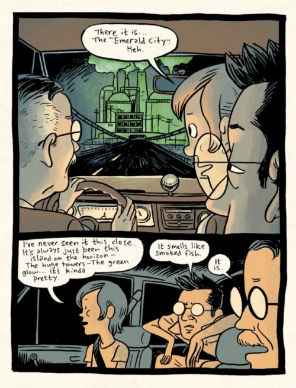 It’s difficult to guess how much of At the Shore changed from Campbell’s original vision to the book it is today. The first Xeric Award-winning chapter came out in 2005 under a different name with the flashback sections seemingly part of an entirely different story about a girl named Marianne. But one can see its evolution from a more grounded emotional story to more adventurous fare as following the path indie comics took in the years it was being worked on. The years in which working for Cartoon Network, or on licensed properties for the child and young adult markets, became a viable career path for artists in the scene. Most certainly it became a path for Campbell. That he was able to handle this shift in tone on all aspects of his visual storytelling yet keep this book a consistent whole speaks much to his talents as a cartoonist.
It’s difficult to guess how much of At the Shore changed from Campbell’s original vision to the book it is today. The first Xeric Award-winning chapter came out in 2005 under a different name with the flashback sections seemingly part of an entirely different story about a girl named Marianne. But one can see its evolution from a more grounded emotional story to more adventurous fare as following the path indie comics took in the years it was being worked on. The years in which working for Cartoon Network, or on licensed properties for the child and young adult markets, became a viable career path for artists in the scene. Most certainly it became a path for Campbell. That he was able to handle this shift in tone on all aspects of his visual storytelling yet keep this book a consistent whole speaks much to his talents as a cartoonist.
Jim Campbell (W/A) • Alternative Comics, $19.95
Review by Robin Enrico





